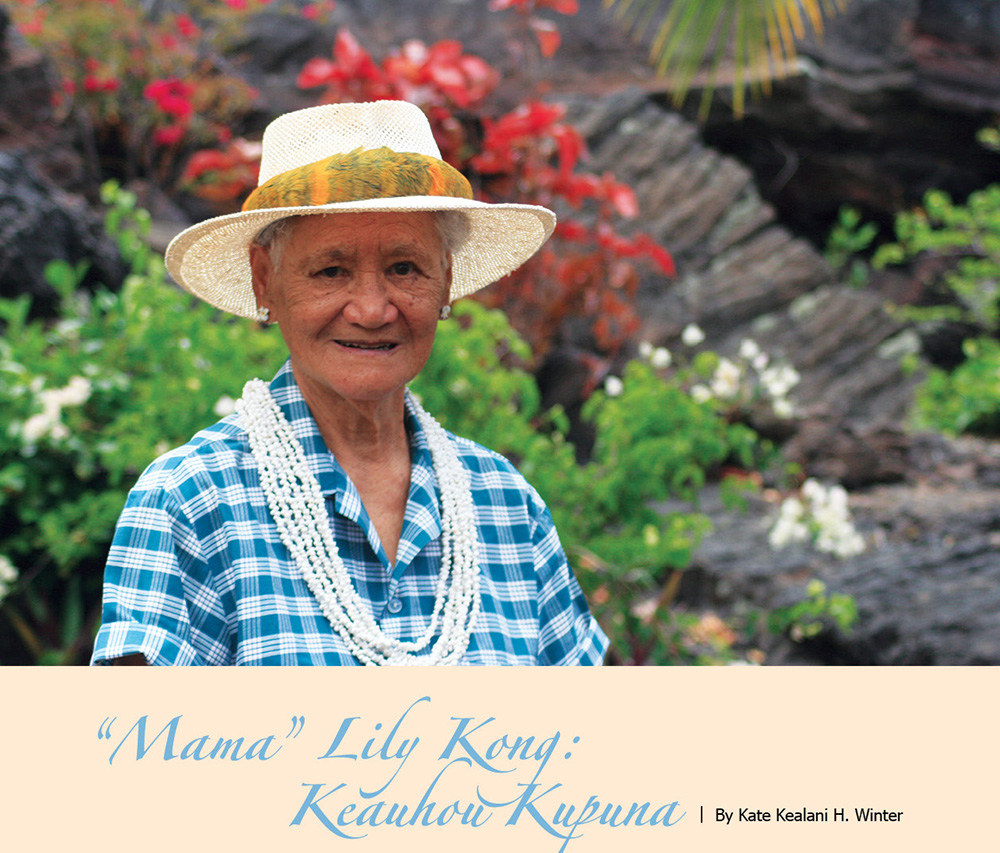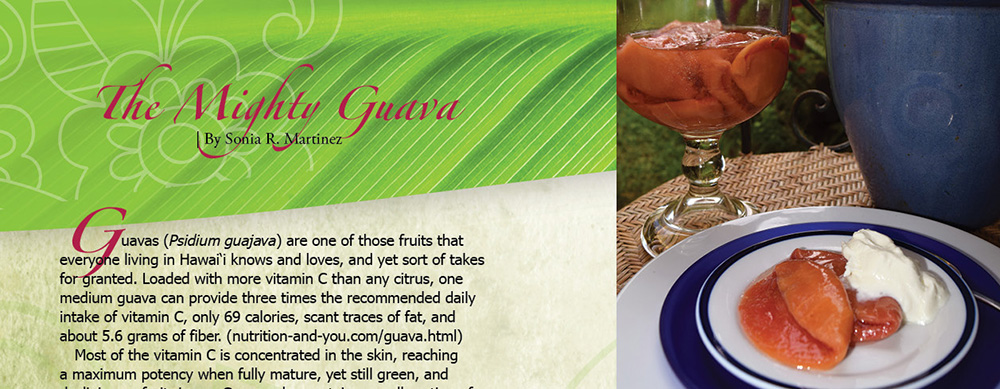
“Mama” Lily Kong: Keauhou Kupuna

By Kate Kealani H. Winter
Mama Lily’s two pairs of boots sit near the door of the family house in Keauhou mauka. Up before dawn as usual, daughter Lily can’t find “Mama” in the house and sees that one pair of boots is gone. She knows her mother is out on the farm somewhere so she goes searching. The younger Lily finally finds the elder standing in the dark under the mango tree holding her machete.
Mama simply says, “I’m waiting for the sun to come up.”
This is the “Mama” of Mama’s Kona Coffee, the deceptively petite matriarch of a fourth generation of coffee farmers.
Mama Lily began farming as a child of six or so when she learned that coffee berries must be picked when red and ripe or the rain will knock them to the ground. She had the job of picking up the coffee that had fallen, helping to dry the coffee and planting taro and pumpkin in the family garden.
There was no running water then, only buckets to carry the sweet water of the uplands. There were no motors—only donkey and mule.
The ‘ohana (family) grew most of their own food, fished, and kept pigs, chickens, ducks and milk cows.
Lily was the seventh of 11 siblings, and everyone had responsibilities up on the coffee farm and down at the bay.
After a day of working up mauka (inland), everyone had to help carry firewood and fresh-picked fruit back down the old Keauhou trail the mile or so to the house on the north side of Keauhou Bay. In those days, Kona district schools kept a “coffee schedule” so that school vacations came during the months when ripe coffee demanded every family member’s help with the harvest August through October.
As a girl, Lily picked and carried burlap bags of coffee, each about 100 lbs, for 50 cents apiece, and she is still thankful to have had the donkeys Charley and Nancy and Johnny the mule to help haul those bags to the coffee mill.
All the children traveled the rural district on foot or donkey and walked barefoot to school up the mauka-makai (inland-ocean) trail about three miles because there was no school bus for elementary children. If someone needed a ride somewhere, they waited at the side of the road for an hour or two before a vehicle would come by and give them a lift.
The hard days were relieved by time down at the shore at Keauhou Bay or spent suspended in the darkness of the Aloha Theatre in Kainaliu, where a Saturday matinee only cost 10 cents.
In those days, it was the Tanimoto Theatre, named for its owner who was good friends with Lily’s father. Sometimes he gave the ‘ohana free passes for Saturday night movies. There were few cars in Kona then—only doctors, ranchers, delivery services and cab drivers could afford them—so most people walked everywhere.
On movie Saturdays, though, her father would send Lily to the neighbor’s house to call Mr. Oshima’s taxi for 5 o’clock pickup. They had to get to the theater early to get seats for the 6pm show, which was always full house because movies were the only entertainment in mauka Kona unless you went down to the beach.
Far from being diminished by the brutally hard work of farm life, Lily grew to be strong and deeply spiritual. Her lively eyes, straight back, and thoughtful manner reveal a kupuna of Keauhou who shares the importance of living in harmony with the land. “Take care of the land and the land will give back. Be greedy with the land and the land will eat you up,” Lily warns.
As a cultural advisor for the resort at Keauhou Bay, she has assisted with identifying and preserving historical features on the property. She tells the stories that keep the land alive for generations to come, even when the markers are gone.
She has often been asked to consult on development matters in the area, sometimes needing to “give ‘em good scolding” when they lack proper respect for the land and the water.
Once, when she was invited to talk story about problems at a hotel on the beach, Lily took three kī (ti) lei with her and hung them, not on the men who had asked her for her knowledge, but on the railing that separated them all from a dying pond.
She insisted on a chant and an apology to the ‘āina for the damage and disrespect done to it by building the hotel there.
While working with landscapers during construction of the old Kona Surf Hotel (now Sheraton at Keauhou), she walked the property explaining the significance of the trees and plants. At one spot, she told them that none of the ‘opiuma (Manila tamarind) trees could be removed because they marked where fishermen had been buried. The trees still remain.
Lily’s response to the turmoil of development and the need for protection of the environment is direct: people need to learn “why things are how they are.”
If we understand that sunshine heats up one side of a plant in the morning and a different side later in the day, we understand why we pick a particular plant at a particular time of day. It is knowing how to interact with living elements in ways that honor them, not just some quaint tradition.
Like the knowledge of herbal medicine that she shares with students, this way of deep observation and right action extends to issues of child abuse, homelessness, and—of course—development.
Acknowledging that development will continue in the Kona district, she tells us we need to go slowly and carefully toward it so we do not lose what is sacred and valuable in the process.
Lily took many life lessons from her father and shares them in wise anecdotes that punctuate her stories. One defines her way with people: “Everybody is special because they know something you don’t know, and you know something they don’t know.”
When she was a child, Lily’s father took her to Sunday school even though he would not attend church himself. He believed that churches historically had mistreated Hawaiians, and he wisely told Lily to “learn all you can. I will teach you the rest.”
Only 14 years old when he died, she feels his presence and guidance always.
“Wherever I walk, I feel someone following me. It is him,” Lily says.
She learned from her father that heart and mouth speak directly to Akua (God), so there is no need for someone to do it for you. Lily herself communes with the spirits of places and people by pule (prayer) and interpreting signs and omens. In her presence, we feel the spiritual power of her connection to everything around her.
Mama Lily seems to move in two realms at once: the mystical and the ordinary. She reminds us that the old trails are as important as roads. Her house is built on an old donkey trail, and she tells her daughters to keep certain doors open so the spirits that walk the trail can pass through.
She says matter-of-factly that menehune had a village on the north side of Keauhou Bay. The legendary race of magical little people who only work at night are responsible for building stone structures, walls, temples, and fish ponds wherever needed. They miraculously finish herculean projects before dawn breaks, so they are rarely seen.
Once, when Lily was down at the shore, she made the mistake of putting the chicken she was lunching on down beside her. When she reached to take a bite, it was gone—taken by a menehune who was equally hungry.
Since then, whenever she returns to that spot at the bay, she takes enough food for herself and the menehune.
Today, the menehune are fanciful figures used in advertising, however Lily has proof that they exist.
In the 1970s there was a family wedding down at the shore. As the day waned, sunset formed a lovely background for the wedding photos. Only later did Lily and the ‘ohana discover that someone besides the bride and groom had been captured on film. A dark, childlike face can be seen peeking out from behind a tree—perhaps the only time menehune have been caught on camera.
Mama Lily’s advice to those who want to see is simple.
“If you open your heart, and your mind is clear, when the sun starts to go down and the winds are calm, you can hear the fishermen coming into shore with their catch…and if you are quiet enough, the menehune might just let you see them.”
Mama Lily’s stories come in a mix of Hawaiian and English translating Hawaiian, sharing a precious lesson with her audience. Her fluency is a gift to children studying the native language, and has helped many historians as she translates old documents to facilitate better understanding of the history and culture.
She recalls in detail the day in her childhood when a man on horseback approached her as she was picking in her mother’s garden near the house. In Hawaiian he asked her where her mother was, and in “haole English” she answered him.
He grabbed his bullwhip and cracked the air with it, then told her in Hawaiian to speak Hawaiian and go get her mother. After that, she says it was the rule that if you were spoken to in Hawaiian, you must respond in Hawaiian, respecting the language of the maka‘āinana.
After living for a time in Honolulu and marrying there, Lily came home to mauka Kona with a young family of her own. When she inherited her farm, she returned to coffee farming and living the mauka-makai life again.
As a wife and mother, Lily and her ‘ohana would often spend weekends at the beach at Kahalu‘u camping with other families, continuing the traditions of her childhood. During the day, she and her friend, Josephine Kamoku, would fish with cross net. After laying the net between them across the path where the fish were swimming, they would signal the rest of the ‘ohana to herd the fish toward the net as the two women closed it around them. A pleasant day would wind down with Hawaiian music by the group that continued to gather. Sometimes guests from the hotel would drift over and be invited to join in the real spirit of aloha. At night, everyone slept on mats on sand that was still warm so no blankets were needed.
Times and tides have changed Kahalu‘u beach since those nostalgic days. The beach became crowded, the sand was carried out to sea, and the government made rules and regulations for Kahalu‘u that include no lay net fishing.
Politicians wanted plenty of fish left there for tourists to see, so parents like Mama Lily, who wanted to teach their keiki (children) the culture, had to find other places.
“We lost the music and the happy times at Kahalu‘u. Too much has been given over for the tourists and not enough left for the Hawaiians. But I still have my memories. And every once in awhile, when we have our Hawaiian culture meetings there, I look over at the beach, and I can hear the singing in my heart.” ❖
Contact Mama Lily Kong
Contact writer Kate Kealani H. Winter


